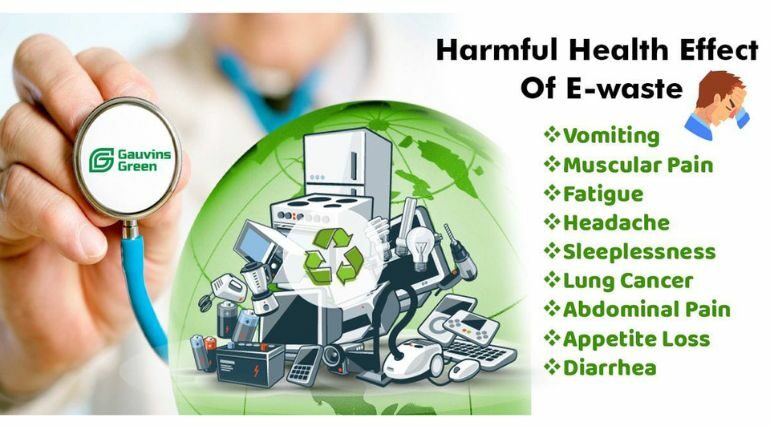Electronic waste or e-waste is a growing environmental problem that poses a serious threat
to human health. With the proliferation of electronic devices and increasing aging, e-waste
has become a major problem worldwide. Therefore, it is crucial to understand the health
impacts of e-waste and explore possible solutions for e-waste recycling and e-waste
disposal services.
Health Effects of E-Waste
- E-waste contains a variety of hazardous substances including lead, mercury, cadmium,
arsenic, brominated flame retardants and polyvinyl chloride (PVC). When released into the
environment, these substances can pollute the air, water and soil and pose serious risks to
human health.
Exposure to e-waste can cause a variety of adverse health effects, including:
Respiratory problems: Inhaling e-waste particles can cause respiratory problems such as
asthma, bronchitis and lung cancer. - Reproductive and developmental disabilities: Exposure to e-waste can cause reproductive
and developmental disabilities, including birth defects, infertility, and miscarriage. - Skin Conditions: Contact with e-waste can cause skin irritation, rashes and burns.
- Neurological Disorders: Exposure to e-waste can cause neurological disorders such as
seizures, headaches and dizziness. - Cancer: Exposure to e-waste is associated with an increased risk of several types of
cancer, including lung, liver and breast cancer. - Endocrine Disorders: E-waste may contain endocrine disrupting chemicals that can lead to
hormonal imbalances and reproductive problems.
E-waste Solutions (Disposal Method)
In order to mitigate the harmful effects of e-waste, it is imperative to implement effective
e-waste disposal solutions. One such solution is e-recycling, which involves disposing of ewaste safely and responsibly. E-recycling is an essential step in reducing the amount of ewaste generated and can help recover valuable materials that can be reused.
- The recycling of electronic devices includes the following stages:
- Collection: E-waste collection from home, companies and institutions.
- Separate collection: E-waste is separated according to type and condition.
- Decommissioning: E-waste is broken down into its components, which are then sorted for
further processing. - Recycling: E-waste is processed using various techniques such as smelting and refining to
recover valuable materials such as gold, silver and copper. - Disposal: All remaining waste is disposed of safely and responsibly.
Reducing the amount of e-waste generated
One of the most effective e-waste solutions is mainly to reduce the amount of e-waste
generated. This can be achieved by adopting sustainable consumption habits and by using
electronic devices for as long as possible.
Consumers may also choose to buy electronic devices that last longer and can be repaired
or upgraded, rather than throwing them away. Electronic equipment reuse Another solution
to the e-waste problem is electronic equipment reuse. Electronic devices that are still
functional can be reused in or donated to people who can use them. This can help extend
the life of electronic devices and reduce the amount of e-waste generated.
Implement green manufacturing practices
Manufacturers can implement green manufacturing practices to reduce the environmental
impact of electronic devices. One way to do this is to use renewable energy sources like sun
or wind to power their factories.
In addition, manufacturers can reduce the use of hazardous substances in manufacturing by
using non-toxic materials and avoiding the use of harmful chemicals in the manufacturing
process.
In addition, the development of electronic devices that are easier to disassemble and repair can
lead to a reduction in the amount of e-waste and an increase in the lifespan of the devices.
Overall, the introduction of environmentally friendly manufacturing processes can make a
significant contribution to reducing the environmental impact of electronic devices.
The health effects of e-waste are a growing concern in today’s world. E-waste contains toxic
chemicals that can have serious effects on human health, and improper disposal of e-waste
can exacerbate these effects. It is important to understand the health effects of e-waste as
exposure can lead to various health problems including respiratory problems, skin irritation
and headaches. In order to mitigate the health impact of e-waste, it is essential to properly
dispose of electronic devices and reduce the overall consumption of electronic devices. In
this way we can minimize the amount of e-waste produced and protect ourselves and the
environment from the negative health effects of improper disposal.
Conclusion
Improper disposal of electronic waste can have serious consequences for human health and
the environment. Appropriate recycling and disposal methods should be in place to reduce
the risks associated with e-waste and protect public health.



2 thoughts on “Harmful Health Effects of E-Waste”